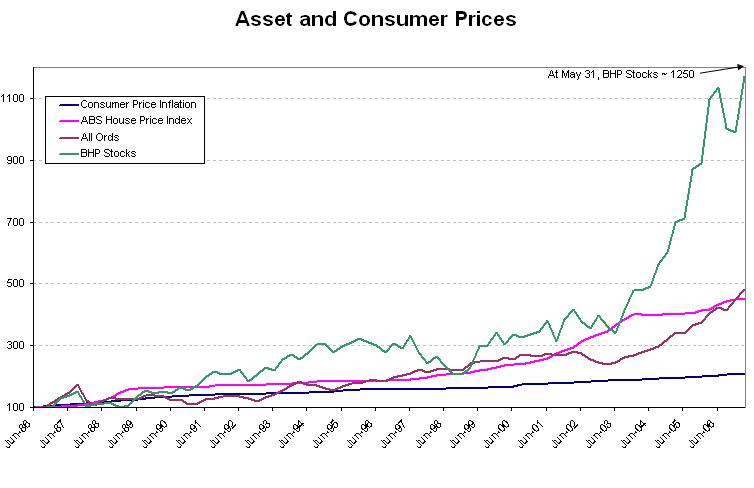"It's a simple demand and supply equation," he said, pointing to the flood of savings going into superannuation and the strong outflow of capital from developing countries such as China, India and Russia to developed countries.
These flows may help to explain the rise in the price of Macquarie Bank shares, but they cannot explain the global rise in the relative value of assets compared with consumer goods and services.
I note in particular that the rise of China shares is itself relatively large, which cannot be due to a rise in capital flowing out of China!
Advertisement
The alternative theory is that the rise of China, India and Russia helps to explain the low level of goods and services inflation. The growth of manufacturing capacity in these and other developing nations has been matched by a flood of cheap workers to produce a global check to goods and services inflation notwithstanding excessively lax monetary policy in the major nations. The net result has been the spill-over of excess money into asset prices, as asset demand has run well ahead of supply.
Of the major developed nations, US monetary policy was the easiest, with the US Fed allowing cash rates to reach an amazingly low 1 per cent in 2003. Other central banks, including Australia's, have run monetary policy that was easy to a greater or lesser degree, and the resulting flood of cheap money has fuelled massive asset price inflation globally.
If this analysis reminds you of the debate over climate change, you have grasped the main points. And the consequences of too sudden corrective action would be similarly costly.
The question of course is what should be done about the situation. Easy money has helped fuel a global asset boom, and asset booms always lead to busts. So what can be done to avoid a bust?
It is a bit rich to see Alan Greenspan warning of the coming bust in China shares, when it was his policy that helped create that boom and the global asset boom in general.
Clearly, savage deflation is not the answer; just as inhibiting industry suddenly is not a sensible approach to global warming. The best approach may be to hold monetary policy firm while asset prices stabilise and then correct, easing only if the inevitable correction seems likely to turn into a bust. The problem is global, so a co-ordinated response among major central banks will be needed. There should be no complaints if Reserve Bank officials spend a disproportionate amount of time at the front of large aeroplanes.
Advertisement
In the longer term, in setting the degree of ease or tightness of monetary policy two matters need to be kept firmly in mind. The first is that global conditions must be well to the fore. The second is that asset inflation needs to be given equal weight to goods and services inflation.

First published in Henry Thornton and The Australian on June 5, 2007.
Discuss in our Forums
See what other readers are saying about this article!
Click here to read & post comments.
5 posts so far.